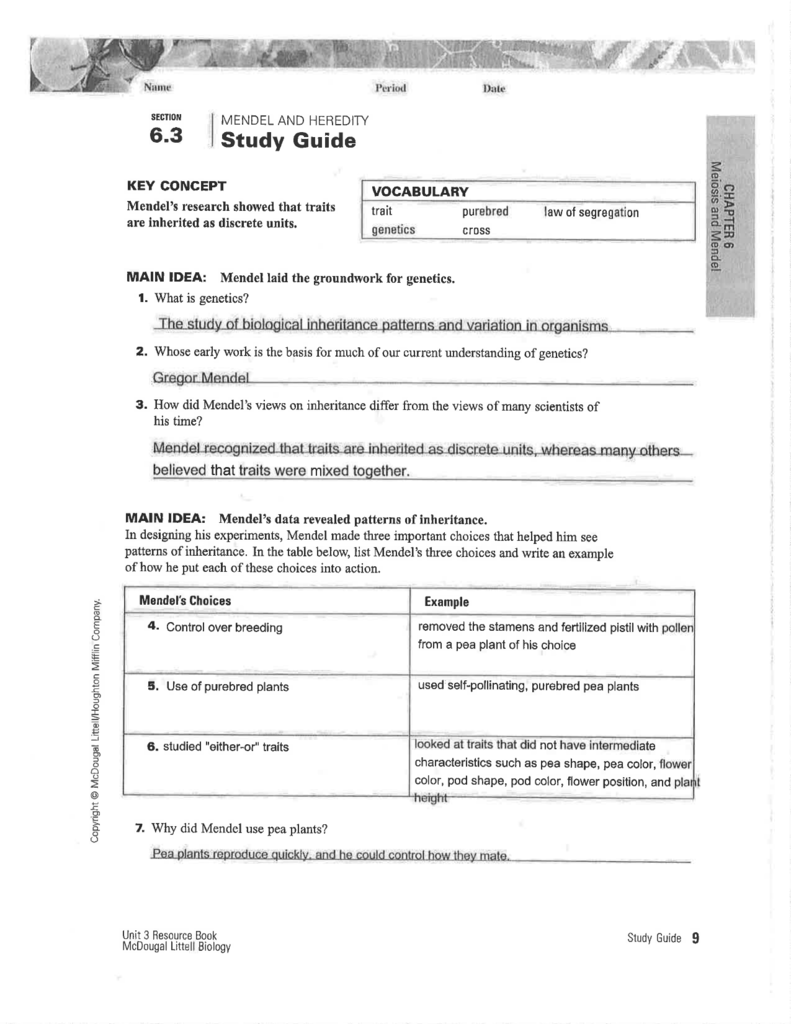Study Guide Answers For Mendelian Genetics
Study Guide for Mendelian Genetics Study Guide and Study Questions: Mendelian Genetics Reading assignments are from 'Biology', Fifth Edition by Campbell, Reece and Mitchell. Read Chapter 14. Know all bold-face terms. Also study Fig.
262 of Chapter 15. Understand what is meant by the 'particulate' vs 'blending' model of inheritance. Clarify the definitions and distinctions between these terms: character, trait, gene, locus, allele. Did Gregor Mendel observe genotypes or phenotypes in his experiments with garden peas? Why not both?. Explain why an organism which is true-breeding for a certain character must be homozygous for that character.
In a monohybrid cross of true-breeding parents,what ratio of traits do you expect in the F 1 generation? What ratio do you expect in the F 2 generation? (Assume this gene exhibits complete dominance). After repeatedly observing the pattern of inheritance described in the answer to the previous question, Mendel developed an explanatory hypothesis which your text breaks down into 4 main ideas. What are these 4 ideas?.
Which give you more genetic information, phenotype or genotype?. What is a testcross and why is it done?. Explain Mendel's law of segregation in terms of meiosis - that is, when does the event described in Mendel's law occur during meiosis (be specific)?.
In a dihybrid cross of true-breeding parents, what ratio of traits do you expect in the F 1 generation? What ratio do you expect in the F 2 generation?
(Assume both genes exhibit complete dominance). After observing the pattern of inheritance described in the answer to the previous question, Mendel developed his second law. What is this law called? At which specific phase of meiosis do you see the chromosomal basis of this law?. What is the Rule of Multiplication?
Sep 24, 2018 - Mendelian Genetics Study Guide Answers chapter 7 extending mendelian genetics - weebly - chapter7 extending mendelian genetics key. Oct 3, 2018 - Mendelian Genetics Study Guide Answers Pdf chapter 7 extending mendelian genetics - weebly - chapter7 extending mendelian genetics key.
Give an example using the flipping of 2 coins. (Hint: What is the probability of tossing 2 heads?
1 head and 1 tail?). What is the Rule of Addition? Give an example using the flipping of 2 coins.(Hint: What is the probability of tossing 2 coins and having at least one head showing? Think of all the possible combinations.). In a monohybrid cross involving a gene exhibiting incomplete dominance, how many phenotypes do you expect in the F 1 generation? How many genotypes?
Study Guide Answers For Mendelian Genetics Problems
How does this differ from expected number of phenotypes and number of genotypes seen in a monohybrid cross involving a gene exhibiting complete dominance?. In a monohybrid cross involving a gene exhibiting incomplete dominance, how many phenotypes do you expect in the F 2 generation? How many genotypes?
How does this differ from expected number of phenotypes and number of genotypes seen in a monohybrid cross involving a gene exhibiting complete dominance?. The gene responsible for Tay Sachs disease exhibits co-dominance. Does a person heterozygous for Tay Sachs have the disease? Understand the three important points about dominance/recessiveness explained on p. Why are lethal recessive alleles much more common than lethal dominant alleles? The URL of this page is www.courses.psu.edu/courses/biol/biol110hw7 D.
Sillman dys100@psu.edu October 1, 2000.

Mendel's Experiments Step One: Mendel allowed plants to self-pollinate for several generations to make sure that they were 'pure', or true-breeding for flower color. Today, we describe each of these 'pure' plants as homozygous. Step Two: Mendel took two pure flowers (one purple and one white), cross-pollinated them. He called these two flowers the P generation (P for parental). Results: All offspring were purple; he called these offspring the F1 generation (F1 for first filial) Step Three: Mendel allowed the F1 flowers (which were all purple) to self-pollinate.
The new offspring were called the F2 generation (second filial generation). Results: Roughly 3 out of every 4 (75%) flowers was purple and 1 out of every 4 (25%) was white.